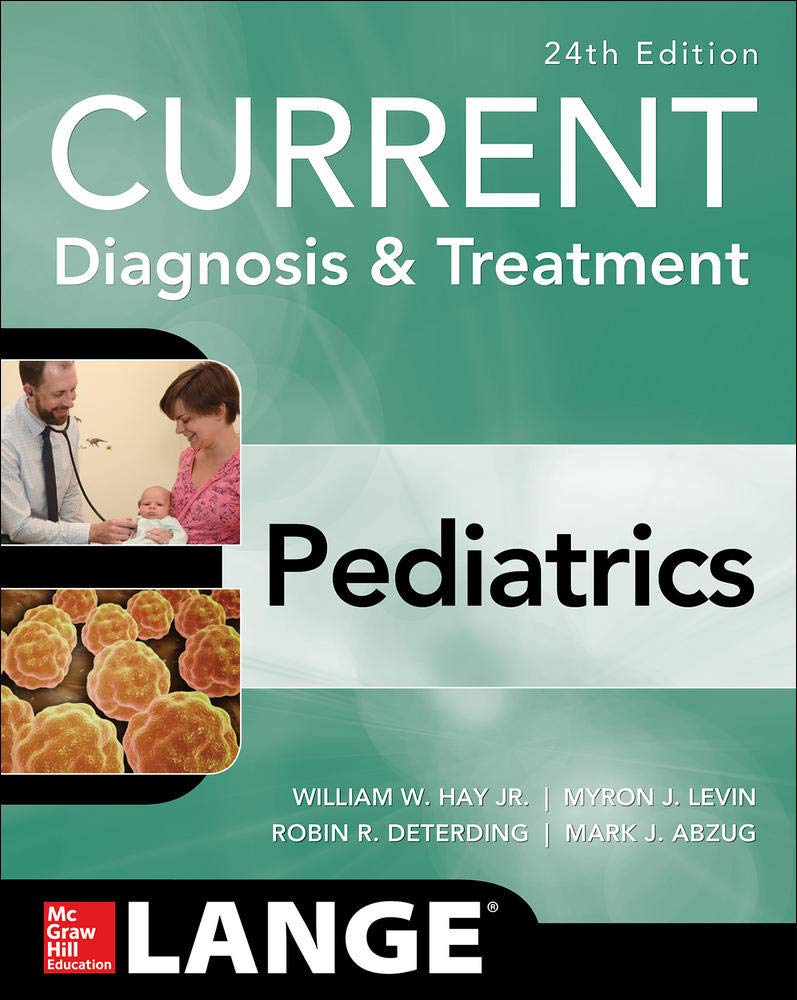CURRENT Diagnosis and Treatment Pediatrics 24th Edition Hay Levin Test Bank
Digital item No Waiting Time Instant DownloadChapters: ALLFormat: PDFISBN-13: 978-1259862908ISBN-10:1259862909Publisher: MG HillAuthors: William Hay, Myron Levin, Robin Deterding, Mark Abzug
In Stock
Original price was: $55.00.$24.00Current price is: $24.00.
CURRENT Diagnosis and Treatment Pediatrics 24th Edition Hay Levin Test Bank
CURRENT Diagnosis and Treatment Pediatrics, 24th Edition by Hay & Levin – Test Bank
CURRENT Diagnosis and Treatment Pediatrics, 24th Edition by William W. Hay, Jr., MD, and Myron J. Levin, MD, is a comprehensive guide for the diagnosis and treatment of pediatric conditions. The test bank for this edition is an essential resource designed to aid both students and educators in assessing and reinforcing the knowledge presented in the textbook.
Overview
Purpose and Use
- Exam Preparation: The test bank serves as a crucial tool for students preparing for exams, offering a variety of question types that reflect the content and style of those found in actual clinical settings.
- Knowledge Reinforcement: It helps in consolidating the material covered in the textbook, ensuring a thorough understanding of pediatric diagnosis and treatment.
- Teaching Resource: Educators can utilize the test bank to create quizzes, tests, and assignments, facilitating the evaluation and enhancement of student learning.
Key Features
Content Organization
- Alignment with Textbook: Questions are organized to correspond with the chapters and topics covered in the 24th edition of CURRENT Diagnosis and Treatment Pediatrics.
- Comprehensive Coverage: Encompasses a wide range of pediatric topics, including growth and development, common pediatric diseases, preventive health care, and management strategies for various conditions.
Question Types
- Multiple-Choice Questions (MCQs): Designed to test a broad range of knowledge from basic principles to complex clinical scenarios.
- True/False Questions: Help in assessing students’ understanding of fundamental pediatric concepts and facts.
- Fill-in-the-Blank Questions: Evaluate students’ recall of key terms and definitions.
- Short-Answer Questions: Require detailed explanations or descriptions, testing deeper comprehension of the material.
- Case Studies: Present clinical scenarios that require students to apply their knowledge to real-world situations, enhancing critical thinking and problem-solving skills.
Answer Rationales
- Detailed Explanations: Each question includes a thorough rationale explaining why the correct answer is right and why the other options are incorrect.
- Clinical Insights: Rationales often provide additional information that offers context and helps students understand the clinical significance of the concepts being tested.
Key Topics Covered
Growth and Development
- Developmental Milestones: Normal physical, cognitive, and emotional development.
- Growth Disorders: Identification and management of growth abnormalities.
Nutrition
- Nutritional Requirements: Essential nutrients and dietary needs for different pediatric age groups.
- Nutritional Disorders: Diagnosis and treatment of conditions like obesity, malnutrition, and eating disorders.
Preventive Health Care
- Immunization: Recommended vaccination schedules and management of vaccine-preventable diseases.
- Screening and Health Maintenance: Guidelines for routine pediatric screenings and preventive measures.
Common Pediatric Conditions
- Infectious Diseases: Diagnosis and treatment of common infections like influenza, measles, and respiratory syncytial virus (RSV).
- Chronic Conditions: Management of long-term conditions such as asthma, diabetes, and epilepsy.
Acute Care
- Emergency Situations: Immediate care for acute conditions such as trauma, poisoning, and acute respiratory distress.
- Hospitalization: Care and management of hospitalized children.
System-Specific Disorders
- Cardiovascular System: Congenital and acquired heart diseases.
- Respiratory System: Respiratory conditions including bronchitis, pneumonia, and cystic fibrosis.
- Gastrointestinal System: Common GI issues like gastroenteritis, constipation, and inflammatory bowel disease.
- Neurological System: Neurological disorders including seizures, cerebral palsy, and developmental delays.
- Endocrine System: Disorders of the endocrine system such as thyroid dysfunction and growth hormone deficiencies.
- Musculoskeletal System: Conditions affecting bones, muscles, and joints, including fractures, scoliosis, and juvenile arthritis.
- Genitourinary System: Disorders of the urinary and reproductive systems, including urinary tract infections and congenital anomalies.
Benefits of the Test Bank
For Students and Practitioners
Comprehensive Review
- Extensive Coverage: Ensures a solid understanding of pediatric diagnosis and treatment concepts.
- Practice Questions: Enhance comprehension and retention through targeted practice.
Effective Exam Preparation
- Realistic Questions: Reflect the format and content of actual pediatric exams.
- Detailed Rationales: Provide valuable insights into the reasoning behind correct answers.
Flexible Study Resource
- Targeted Study Sessions: Allows for focused review on specific areas of interest or difficulty.
- Supplemental Material: Supports efficient and thorough exam preparation.
For Educators
Supplemental Teaching Tool
- Integration into Curriculum: Can be used in lectures, discussions, and assignments.
- Assessment and Feedback: Helps evaluate student understanding and guide instructional activities.
Practical Applications
Self-Study and Review
- Structured Study Sessions: Utilize the test bank for systematic review and consolidation of knowledge.
- Practice Exams: Assess readiness and identify areas needing further focus.
Group Study Sessions
- Collaborative Learning: Use practice questions and rationales for interactive study and discussion.
- Enhanced Understanding: Engage in group activities to apply and reinforce pediatric concepts.
Exam Preparation
- Comprehensive Practice: Prepare for exams with practice questions and detailed explanations.
- Real-World Scenarios: Use case studies to simulate exam conditions and improve problem-solving skills.
Conclusion
The Test Bank for CURRENT Diagnosis and Treatment Pediatrics, 24th Edition is a vital resource for students and educators in the field of pediatrics. Its extensive range of practice questions, detailed rationales, and alignment with the textbook’s content make it an excellent tool for mastering pediatric concepts and achieving academic and professional success. Whether for individual study, group review, or educational purposes, this test bank supports effective learning and assessment in pediatric diagnosis and treatment.


Reviews
There are no reviews yet.